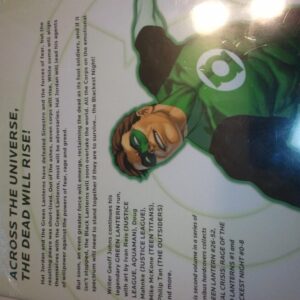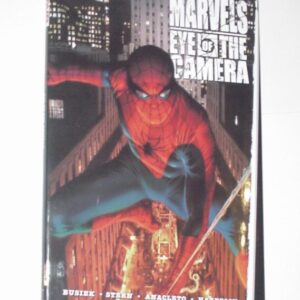A Touch of Silver HC Jim Valentino 1st printing Image Comics 1997
$149.99
Description
This book was featured in Wizard Magazine # 108 feature: Truly Rare Gems since it was never offered through Diamond. The only way you could get it was by sending in an order form in the back of a comic. A great book!
In 1997 Jim Valentino began a series in black and white called A Touch of Silver, a semi-autobiographical novel about a young comic book fan coming of age in the 1960s.
Timmy Silver is a shy, precocious young boy trapped in the middle of a dysfunctional life. His family is being torn asunder by a cheating father and weak-willed mother. He is besieged at school by playground bullies. His only solace lay in his drawings, his imagination and his comic books. Set in the early 1960’s, this sad, sensitive story is for anyone whose life wasn’t `The Donna Reed Show.
A Touch of Silver chronicles the life of a young boy by the name of Tim Silver, beginning with the slow disintegration of his life in October of 1962. “Tim” of course rhymes with “Jim,” making one wonder how much, if any, autobiographical viewpoint we’re getting here. Set in Westminster, California, we experience Tim’s life with a sense of very real identification. Consequently, Tim’s story, his environment, has resonance for us because many of us have been in the same mindset as he.
For Tim is a comic book fan, you see. Moreover, he is the classic comic book fan. Small, uncertain, unpopular, seeing the world as a place where parents and bullies hold all the power. The only place where Tim can find escape is the realm of comic books, where virtue guarantees eventual triumph. Where heroes can leave unpleasant circumstances simply by vaulting skyward, and nobody messes with them except supervillains, who invariably get trashed anyway.
What’s particularly attractive is the subjective manner in which Valentino as writer and artist–ably abetted by the lettering of Tami Doll (a name which cries out for a 1950s doo-wop song all its own)–puts across the subjective manner in which Tim views the world. Or, if you want to take it a step beyond that, how an adult Tim recalling his childhood might give emphasis to certain aspects of his life.
Adults, for example, when getting particularly strident, switch from standard word balloons to big open block lettering. His mother and father, when getting particularly irate, go from Valentino’s stylistic norm to wild-eyed, slavering caricatures that look like something that wandered in from a Peter Bagge comic. It makes sense from a child’s perspective: Who among us doesn’t remember being screamed at by a parent whose open and shouting mouth seemed suddenly to constitute about three quarters of the face?
His time in school is depicted in panels that have ziptones, scratch marks and such that obscure them… indicating either that one day of blah school experience tends to blend into the next and the next, shapeless and indistinguishable… or, equally possible (particularly since the same motif occurs during a birthday party for Tim to which virtually no one comes), it’s as if Tim is there in body, but not in mind. Tim, whose interest in writing and drawing his own comics quickly becomes one of the series’ focal points, withdraws from situations which he finds tedious or unpleasant, his mind awhirl with various half-formed images that will eventually coalesce into stories of–naturally–superheros. Stories that will help him escape from the tedium and unpleasantness of his life.
Artistic touches and subjective riffs aside, the first three issues of Silver stick safely to territory that’s been covered by everyone from Leave it to Beaver to Jean Shepherd. There are hints dropped that all is not well in Silver land: His parents’ marriage is troubled, his father is shown in a dalliance with another woman and later making efforts to placate Tim’s mother by spending more, quality time with his kids.
But most of the tale stays safely within Tim’s immediate sphere of influence, and touches on all the childhood fears and difficulties which lend a commonality to growing up–particularly growing up a comics fans. Issue #1 focuses on the aforementioned disastrous birthday party. Issue #2 has Tim’s first, tentative experience with the opposite sex (doesn’t get easier, kid.) And #3 puts Tim in conflict with the school bully. This one had particular identification value for me, because Tim uses stunts he picked up from reading comic books to take down the bully, as did I when I faced off against the school thug back in fifth grade.
In short, the stories are nicely constructed, well told, and emotionally appealing. Hardly groundbreaking, though. With an adult voice-over narration and a bit more whimsy, you’d have credible episodes of The Wonder Years.
But beginning with issue #4, we see Valentino’s true vision for the series. Having laid the groundwork for Tim Silver’s life in the first three issues, Valentino then tears the kid’s life completely apart. The previously established cracks suddenly rip apart—almost without warning—into full-blown crevices, as the Silver parents’ marriage turns into a domestic Vesuvius.
The first rule of a splintering marriage is: Keep the kids out of it whenever possible. In the early parts of the issue, we see the devastating effect that parental bickering has upon children. Tim, old enough to understand, tries to find solace within his comics, penciling a fight scene in which assorted heroes slug it out with the hideous Daddy monster. Tim’s younger sister, meantime, is in quiet denial, playing tea party with her doll and complaining about the “rude and uncouth” neighbors. You just know this kid’s got “therapy” writ large in her future. Like kids growing up in a home with smokers, they choke on the poisonous exhaust given off by a marriage in flames.
But that’s nothing compared to what happens next. Pardon the phrasing of the following since I don’t want to give away everything: The argument reaching a crisis point, one of the parents decides that he or she is leaving, and they explode into the boy’s room, demanding that Tim choose between them.
It’s a hideous sequence—hideous in that you have a feeling that, if little sister is destined for a psychiatrist’s couch, big brother might end up on top of an office building rearranging people’s chest cavities with a high-powered rifle. What we’re seeing here is nothing less than a child being scarred for life. “Who do you love more?!” is the explosive question with which Tim is hammered. He stammers out a name, and you get the sense that it’s hardly the name of the parent he feels a closer bond to, but rather the parent who he’s more afraid of upsetting. Or perhaps Tim was simply trying get out a sentence that would be a plea to his folks not to put him in this ghastly predicament, and he never managed to get beyond the first word of the sentence before being snatched away.
Issue #5 gives us something of a respite from the emotional shellacking that Valentino puts us and his protagonist through, as Tim tries to adapt to a new life, bereft of one of his parents. It’s by far the most involved comic book tie-in, as Tim projects his wish-fulfillment self into a story that beautifully evokes the style and substance of typical 1963 comics (DC-style, Marvel-style, and Alan Moore-style.) Tim, feeling isolated and unwanted, conjures up a daydream in which his alter-ego, Silverboy, is sought after by teams evocative of the Legion, the Fantastic Four, and the Justice League (right down to the classic JLA-style shot that has them running towards camera with their names in captions.) Symbolically recreating his parents’ struggle for his affections, the three teams go at each other in a physical battle to capture Silverboy’s loyalties. And Silverboy–in the mindset of a child who just wishes his life could be normal–desperately wants all the teams to just get be friends with each other instead of battling. Fighting over him is anathema. Deep down, we sense that Tim–like most kids who are victims of divorce–believes that he is responsible for the break-up of his parents’ marriage, and that he and he alone can somehow bring them together.
Would that life were as simple as a 1963-era comic book.
Displaying inventiveness and a deep-seated love for the genre that I haven’t seen from Valentino since normalman, A Touch of Silver goes light-years beyond that in terms of being a personal and important piece of work. Comics parody is one thing. Silver gives us the life of a young boy wherein comic books become not only his hobby and then his love, but also his link to sanity. Like Howard the Duck, Tim Silver is trapped in a world he never made, and comics are his means of survival. In the comics world, he can work out the difficulties in his life that he otherwise would not have the emotional tools to express. Tim is about as far removed from the view of a fan with a bloodless collector’s mentality as one can get.
The characters are multidimensional, the situations achingly real, and the emotional palpable in every pen stroke on the black and white page.
1-887279-79-2
Near mint condition. Book has never been read and it shows.
Related products
-


American TP Mark Verheiden Dark Horse Doug Braithwaite Frank Miller Mike Mignola Jim Lee
$69.99 Add to cart -


Star Trek Archives Volume 1 Best of Peter David TP 1st print NM IDW
$39.99 Add to cart -


Green Lantern by Geoff Johns Volume 2 Omnibus HC 1st print NM Ivan Reis Shrinkwrapped
$324.99 Add to cart -


Marvels Eye of the Camera HC Kurt Busiek Jay Anacleto 1st print
$59.99 Add to cart




